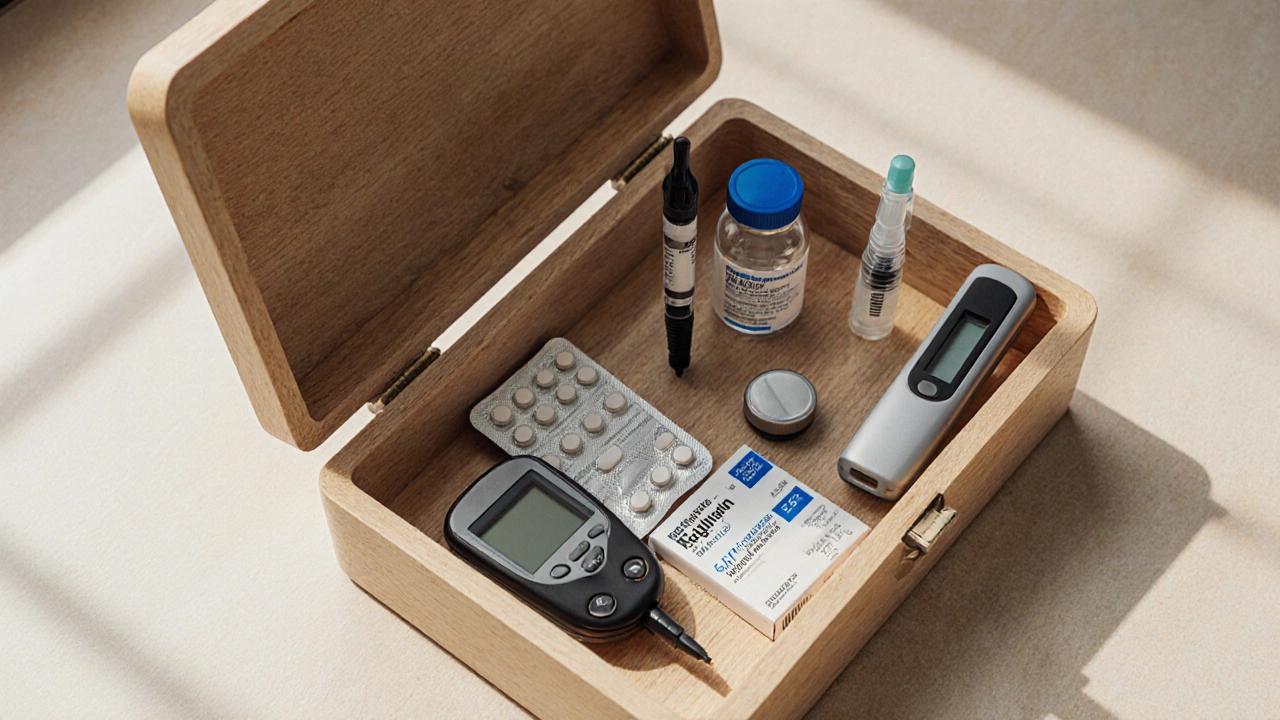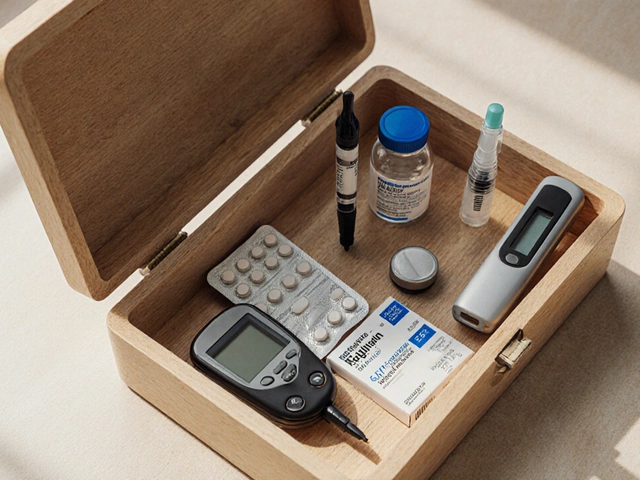Diabetes Medication Selector
Select Your Conditions and Preferences
Answer the following questions to find the best medication for your situation.
Recommended Medication
When you ask, best diabetes medicine, the answer isn’t a single pill-it’s a toolbox. Different drugs work for different bodies, disease stages, and lifestyle goals. This guide breaks down the major options available in 2025, shows how they stack up on efficacy, safety, cost, and convenience, and helps you pick the right one for your situation.
Quick Summary
- Metformin remains the first‑line choice for most people with type2 diabetes because it’s cheap, effective, and has a solid safety record.
- GLP‑1 agonists (e.g., semaglutide) excel at weight loss and cardiovascular protection, but they’re injectable and pricier.
- SGLT2 inhibitors (e.g., empagliflozin) lower blood pressure and guard the heart and kidneys, making them ideal for patients with comorbidities.
- Insulin is essential for type1 diabetes and advanced type2 cases, yet it requires careful dose titration.
- Consider side‑effect profile, cost, and personal preferences when choosing a regimen.
Understanding Diabetes Medications
Diabetes medication is a pharmaceutical agent designed to control blood glucose levels in people with diabetes, either by increasing insulin secretion, improving insulin sensitivity, or reducing glucose production or absorption. The two main disease types dictate the therapeutic approach:
- Type 1 diabetes an autoimmune condition where the pancreas produces little to no insulin - insulin replacement is mandatory.
- Type 2 diabetes characterized by insulin resistance and relative insulin deficiency - a range of oral and injectable agents can be used.
Major Drug Classes in 2025
Below are the most prescribed classes, their mechanisms, typical dosages, and who benefits most.
- Metformin a biguanide that decreases hepatic glucose production and improves peripheral insulin sensitivity - first‑line for virtually all newly diagnosed type2 patients.
- Sulfonylureas stimulate pancreatic beta‑cells to release more insulin - inexpensive but carry hypoglycemia risk.
- Thiazolidinediones (TZDs) activate PPAR‑γ receptors to boost insulin sensitivity in adipose tissue - useful for patients with severe insulin resistance.
- DPP‑4 inhibitors prolong the action of incretin hormones, modestly lowering glucose without weight gain - well‑tolerated, oral.
- GLP‑1 agonists mimic the gut hormone GLP‑1 to increase insulin secretion, suppress glucagon, and slow gastric emptying - strong weight‑loss effect, cardiovascular benefits.
- SGLT2 inhibitors block kidney reabsorption of glucose, causing its excretion in urine - lower blood pressure, improve heart and kidney outcomes.
- Insulin replaces or supplements endogenous insulin; available in rapid‑acting, long‑acting, and mixed formulations - essential for type1 and advanced type2.

Comparison Table: Key Attributes
| Drug/Class | Typical Use | HbA1c Reduction | Weight Impact | Cardio‑Renal Benefits | Common Side Effects | Average Monthly Cost (USD) |
|---|---|---|---|---|---|---|
| Metformin | First‑line for type2 | ≈1.0% ↓ | Neutral or slight loss | Modest reduction in CV events | GI upset, B12 deficiency | ≈$5 |
| Sulfonylureas | Add‑on when metformin insufficient | ≈0.8‑1.2% ↓ | Weight gain | None | Hypoglycemia, weight gain | ≈$10 |
| DPP‑4 inhibitors | Oral alternative with low hypoglycemia risk | ≈0.5‑0.8% ↓ | Neutral | Neutral | Upper respiratory infection | ≈$30 |
| GLP‑1 agonists (e.g., semaglutide) | Especially for overweight/obese patients | ≈1.0‑1.5% ↓ | 5‑10% loss | Reduces MACE, slows CKD progression | Nausea, vomiting, pancreatitis risk | ≈$400 |
| SGLT2 inhibitors (e.g., empagliflozin) | Patients with heart or kidney disease | ≈0.6‑1.0% ↓ | 2‑3% loss | ↓ CV death, ↓ HF hospitalization, ↓ CKD progression | UTI, genital mycotic infection, euglycemic ketoacidosis | ≈$250 |
| Insulin (basal‑bolus) | Type1 or uncontrolled type2 | Variable, often >2% ↓ | Neutral | Neutral | Hypoglycemia, weight gain, injection burden | ≈$100‑$200 |
How to Choose the Right Medicine
Think of medication selection as a decision tree. Ask yourself these questions in order:
- What type of diabetes do I have? Type1 requires insulin; type2 offers many oral options.
- Do I have any cardiovascular, kidney, or weight concerns? If yes, GLP‑1 or SGLT2 classes may give extra protection.
- Is cost a major factor? Metformin and sulfonylureas are budget‑friendly; newer injectables are premium.
- Am I comfortable with injections? GLP‑1 agonists and insulin require subcutaneous administration.
- What side‑effects can I tolerate? For example, avoid sulfonylureas if you’re prone to hypoglycemia.
Most clinicians start with metformin, add a second‑line agent based on the above criteria, and reserve insulin for later stages.
Special Situations
Pregnancy: Metformin is sometimes continued, but insulin remains the gold standard due to safety data.
Elderly patients: Prioritize low‑hypoglycemia risk drugs-DPP‑4 inhibitors or low‑dose SGLT2 inhibitors are common.
Patients with chronic kidney disease (CKD): Early‑stage CKD still allows metformin; SGLT2 inhibitors actually slow CKD progression, while sulfonylureas may accumulate.

Potential Pitfalls and How to Avoid Them
- Ignoring renal function - many drugs need dose adjustment; check eGFR before starting SGLT2 inhibitors.
- Skipping B12 monitoring - long‑term metformin can lower B12, leading to neuropathy.
- Underestimating lifestyle impact - medication works best when paired with diet, activity, and weight control.
- Overreliance on cheap drugs - sometimes a pricier option prevents complications, saving money long‑term.
Frequently Asked Questions
Is metformin still the best first‑line drug in 2025?
Yes. Across major guidelines (ADA, EASD), metformin remains the go‑to starter because it lowers HbA1c by about 1%, costs under $10 per month, and has a long safety record. Newer agents are usually added only after metformin fails or when specific cardio‑renal benefits are needed.
Do GLP‑1 agonists cause dangerous weight loss?
GLP‑1 drugs can produce 5‑10% body‑weight reduction, which is beneficial for most overweight patients. Extreme loss is rare and usually linked to poor diet or mis‑use. Doctors monitor weight and adjust dosage if loss becomes excessive.
Can I take an SGLT2 inhibitor if I have a history of urinary infections?
SGLT2 inhibitors increase glucose in the urine, which can raise infection risk. If you’ve had recurrent UTIs, discuss alternatives (e.g., DPP‑4 inhibitor) with your physician. Preventive hygiene and prompt treatment reduce complications.
When should a type2 patient switch to insulin?
Switch to insulin when HbA1c stays above target despite two oral agents, when fasting glucose exceeds 180mg/dL, or during pregnancy, severe illness, or renal failure where oral drugs lose efficacy.
What monitoring is needed for metformin users?
Check renal function (eGFR) at baseline and annually; monitor B12 levels every 2‑3 years; watch for GI upset and consider dose titration or extended‑release formulation if needed.
Next Steps
1. Schedule a review with your endocrinologist or primary‑care doctor.
2. Bring recent lab results (HbA1c, eGFR, lipid panel).
3. Discuss lifestyle goals - weight, activity, diet - and ask which drug aligns best.
4. If cost is a barrier, request generic options or patient‑assistance programs for GLP‑1 or SGLT2 agents.
5. Set a follow‑up in 3 months to reassess glucose, side effects, and any needed dose tweaks.
Choosing the “best” diabetes medicine isn’t about a single brand; it’s about matching the drug’s strengths to your health profile, budget, and preferences. Armed with this comparison, you can have a focused conversation with your healthcare team and move toward better glucose control and fewer complications.







